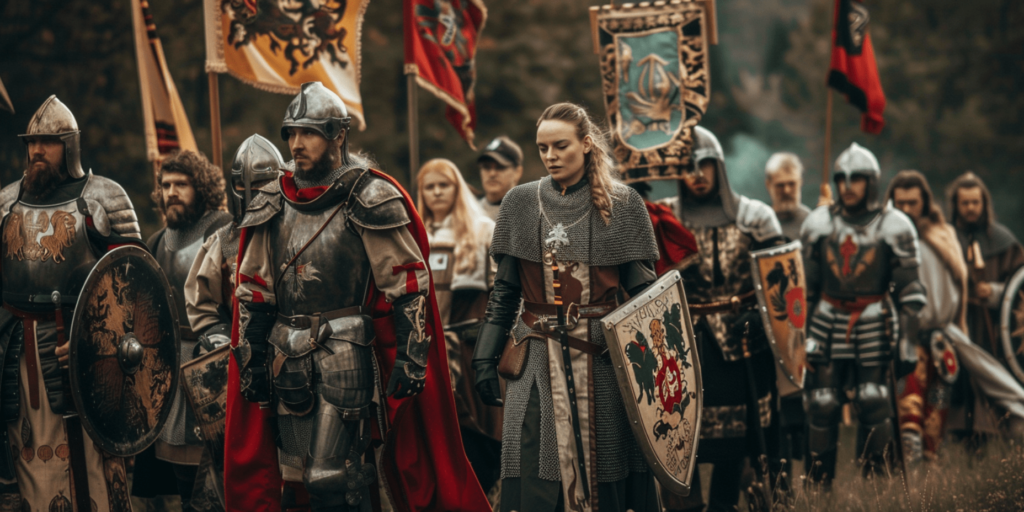The allure of medieval fashion lies in its intricate designs, rich fabrics, and the stories each garment tells. The process of creating your own DIY medieval attire opens up a realm of creativity and historical exploration, whether it is a professional photoset or a themed birthday party.
By learning how to make medieval costumes, you can understand the lifestyle and culture of the medieval period through the prism of fashion. In this article, we will navigate you through the path of selecting the right materials, mastering the art of costume design, and adding finishing touches that breathe life into the fabric, transforming it into a piece of living history.
Designing Your Medieval Costume
Choose a specific period and region. Medieval fashion varied widely depending on the century and location. Gather visual references from historical texts, artworks, and existing garments in museums.
When selecting fabrics, consider the weight and drape, especially for garments like gowns or tunics that require a certain flow. A heavy wool might be perfect for a winter cloak, while a lighter linen suits summer attire. The color palette also plays a significant role; natural dyes offer a range of beautiful, earthy tones. Indigo, madder, and woad provide blues, reds, and greens that were popular in medieval times.
Start applying your insights in practice. If you are new to sewing, use pre-made patterns found online or in the sewing shops. If you are an experienced sewer, you can try drafting your own pattern. Adjust dimensions to fit modern body sizes while retaining historical silhouettes.
Resist the temptation to use modern shortcuts. Take the time to hand-sew visible seams or incorporate period-appropriate closures (like lacing or hand-forged buttons). It is required for your costume to look authentic. When working with a frayed fabric, consider finishing edges with hand-sewn hems or fabric sealants designed for natural fibers.
To imbue your costume with a sense of history, consider aging the fabric. Techniques like tea staining can give new materials a worn, antique look. Slight distressing along edges can mimic wear from years of use.
Use accessories. Leather belts, pouches, and hand-forged metal brooches can add authenticity to the costume. They also provide practical ways to carry personal items, which is essential for that period.
Embellishments such as embroidery, beading, and trim can elevate a costume from simple to regal. In the medieval era, such decorations were often symbols of status and wealth. Incorporating historically accurate patterns and techniques in your embroidery or choosing trims that reflect the era’s styles can add depth and authenticity to your costume. For those new to embroidery, starting with simple border designs or fabric appliqués can achieve a similar effect without extensive handiwork.
Finishing Touches
Research historical references to find hairstyles that match your chosen period and status. Braids, buns, and loose hair were common. The hairstyle choice depended on region and class. For makeup, aim for a natural look. Heavy makeup was not widely used during the medieval period.
Medieval footwear is often the most challenging aspect of the costume. When possible, source shoes or boots that closely resemble historical designs. Focus on materials and styles reflecting the era and location. For those unable to find exact matches, modifying contemporary shoes with covers or embellishments can be an effective workaround.
Use props, such as period-appropriate weaponry, tools, or books. They will add a visual interest and offer an insight into the life of your characters. Choose props relevant to your costume’s time period and ensure they complement rather than overwhelm your outfit.
The sepia photo filter, reminiscent of early photography, can emphasize the historical aspect of your costume. It softens modern elements and enhances the overall period feel. When planning your photo shoot, consider settings and poses that align with your characters’ background, further bridging the gap between past and present.
Conclusion
Engaging in the design and sewing of your medieval costume is not just about creating a piece of clothing; it is about connecting with the past in a tangible, creative way. By embracing the complexities and nuances of medieval fashion, you craft not just a garment but a doorway to another time. Each detail, whether a carefully placed stitch or a handcrafted accessory, contributes to the story your costume tells.

